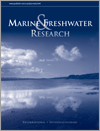Marine and Freshwater Research
Volume 73
Number 4 2022
Stakeholder perceptions of the functioning of individual transferable quota (ITQ) systems in Australia are assessed based on submissions to a Government Inquiry. Views varied substantially between submissions, with most fisher submissions presenting a negative overall view of ITQs, and other groups presenting a more positive view. Issues about ownership of quota was a common theme, with small-scale and lease-dependent fishers particularly disadvantaged.
Increasing pressures from human use are affecting coastal ecosystems worldwide. Researchers are integrating genomic methods in their ecosystem surveys because of their high accuracy, the opportunity to investigate biodiversity across the tree of life, and ease of deployment. Here, we present data from a 2.5-year genomic survey and show how monthly surveys contributed to establishing a baseline that will enable us to understand the variability of the sediment bacteria and, ultimately, how changes in their community structure will affect their ecological roles in a temperate, urbanised estuary.
Guppies are renowned for possessing individual personalities, expressed via traits such as boldness, but the sources of variation for this phenomenon are unclear. We demonstrated considerable individual, sexual and strain-level differences in boldness, but the patterns of variance do not match expectation based on hypothesised forms of sex-specific selection.
There are lessons to be learnt from the agreement and implementation of returning environmental flows to the Snowy River in Australia that may help enhance future river restoration agreements. These lessons centre on the importance of review, the need for clear articulation of what can and should be achieved and the need for consistent monitoring and independent advice for overall transparency.
In summary, D. gigas in our study area changed its habitat two times, first at an early life stage (Section I) and then later in the life (Section V). During the medium stage (Sections II, III and IV), D. gigas inhabited the same place. It has significant differences in trophic preference at different life stages, and tends to have a generalist food spectrum during most of its life history, except for the stage closed to before being captured.
Plastics are a severe threat to natural ecosystems that is predicted to increase. As top-predators, birds are ideal sentinel organisms for monitoring plastic-induced ecosystems change. We examine plastic pollution ingestion by four aquatic bird species in southern Portugal over more than 6 years. We identify species-specific difference but no temporal trends. Our work provides a timely framework in evaluating changes in plastic ingestion through time and among species, and sets a temporal baseline that could aid future effective conservation policies.
Caridina logemanni is a rare freshwater shrimp endemic to Hong Kong with highly restricted distribution, further threatened by harvesting for aquarium trade. We show that their populations are strongly genetically differentiated and had historic hybridisation with the ubiquitous C. cantonensis. This informs future conservation management and highlights the necessity of assessment for similarly poorly known, endemic freshwater taxa.
Despite the general interest in fish larvae, publications on the vertical distributions of fish larvae are surprisingly rare. Here, we have carefully tested hypotheses on the vertical distributions of larvae during the day at multiple locations, in water columns of different depths, over short periods of time (i.e. among days) and between day and night. Interested readers would include: larval biologists, coral reef ecologists, fish biologists, biophysical modellers and those with an interest in reef connectivity.
In this preliminary study, we non-lethally determined the reproductive hormone profiles of blacktip sharks in southern Florida. In general, changes in monthly hormone concentrations were consistent with the timing of reproductive events in blacktips in other regions. However, because of low monthly sample sizes and caveats when using only non-lethal methods, the female profiles raise interesting questions about this population’s reproductive cycle that could be explored in future studies.
The abundance and identification of microplastics were investigated for the first time in the gills and soft tissues of freshwater mussels (Batissa violacea) harvested from five rivers in Fiji. Microplastics were found in samples from all the rivers, with an average concentration of 5.96 ± 0.39 grams per mussel. This is concerning because these mussels are an important source of income and food.
This study analysed for the first time the long-term carbon dioxide (CO2) concentrations in the River Murray, and fluxes from the river to the atmosphere. Elevated CO2 levels in the water relative to the atmosphere were observed, even under low flow conditions in the Millennium Drought. This appears due to internal cycling of organic carbon and respiration within the river. On average the River Murray was estimated to emit approximately 355 000 tonnes of CO2 to the atmosphere each year.
Marine turtles have diverse diets. Analysis of digestive contents is often limited to the hard parts of ingested prey. By comparing the diets of juvenile loggerhead turtles by visual observation and DNA of ingested prey, we show the complementarity of the methods, with the former method allowing the identification of soft prey such as ctenophores and cnidarians.
This study had as objective to estimate life-history traits and analyse yield and abundance fishing levels to see whether Plesionika edwardsii shrimp is vulnerable to overexploitation or not in the Azores region. The life-history trait results showed that P. edwardsii is a relatively long-lived, slow-growing and late-to-maturity species. These results, combined with the time required for depletion and MSY estimates, suggested that this resource is less resilient, highly vulnerable to overfishing and can be easily over-exploited.





